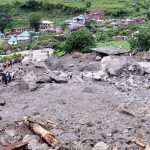A new app promises to help Barcelona residents find the shadiest route between two places to avoid extreme heat.
Cool Walks, a routing tool for pedestrians first developed at a data visualisation contest, aims to show users a variety of walking routes to take for their intended destinations.
Users can choose the most direct route, a shady route that may take a little longer, or they can set the app to “vampire mode”, which avoids direct sunlight at all costs. Users can also use the app to find drinking fountains, or places to shelter from the sun.
The app uses a tool called Lidar to create high-resolution models of ground elevation, accurate to within 10cm. This information is combined with data on the sun’s path to work out where is in shade at any given time of day.
Barcelona is looking to use green spaces and trees as part of its efforts to mitigate the effects of global heating. The city’s 20-year tree masterplan aims to increase the proportion of land covered by trees from 25% to 30%.
Albert Carbonell, lead analyst at the geographic information systems department at urban planning agency Barcelona Regional and one of the developers of the app, said: “I don’t know many cities that deal with pedestrian routing. It’s nice for a public agency to work with data that the city gave to us, to demonstrate that it’s feasible to come up with technological solutions to climate change.”
Although the tool only maps one neighbourhood of Barcelona, it is hoped the research will provide information on how the city can adapt to extreme heat to protect its citizens and economy.
Marc Montlleo, director of environmental projects at Barcelona Regional, said the vampire mode was created from taking “the most extreme form of the data algorithm”.
He said: “We wanted to generate different options so you could pick faster or cooler routes and we calculated three different algorithms. The vampire mode was made from our team who had a lot of beer the night before. It was for a bit of fun to totally avoid sunlight.”
Heatwaves kill more people than any other climate risk. According to C40, a climate leadership group made up of 97 cities around the world, extreme heat events in cities can cause mortality increases of up to 14%, as well as lower workforce productivity and damage infrastructure such as roads and rail lines.
Jon Burke, a former councillor for Hackney in London, who was responsible for a massive expansion of tree planting in the borough, said: “I think we should view this particular kind of app as an interim measure to reduce the impacts of extreme heat … while cities rapidly invest in urban canopy cover and broader green infrastructure.
“The scientific literature on urban forestry is clear: in order to begin reducing temperatures during extreme heat events, we need to be aiming for 40% canopy cover on street as a minimum, and combine this with additional green infrastructure interventions and the systematic removal of heat-trapping concrete, tarmac, and other hard surfaces.
“Leaders also need to think about how to deploy green infrastructure in ways that reduces peak grid electricity demand for cooling, and in highly strategic ways […] Healthcare services will also need to increasingly prepare for excess summer, rather than winter, admissions and deaths.
“Trees and broader green infrastructure is the most advanced technology known for mitigating the impact of our densifying and rapidly heating cities. City leaders should make that their priority in the first instance.”



Average Rating